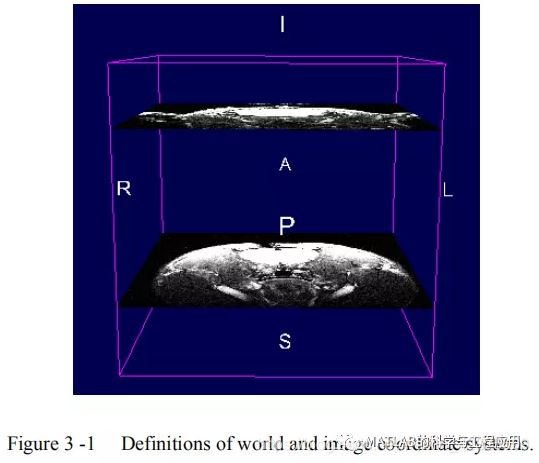
本文为美国伍斯特理工学院(作者:Hongliang Yu)的博士论文,共116页。
在医学和临床应用中,先进的成像技术被广泛应用于解剖结构和功能代谢的研究。图像是从各种扫描仪(CT/MR/PET/SPECT/B超)获取的,这些扫描仪为医生诊断和检测患者的特定区域提供补充信息。然而,由于成像方式和成像方向的不同,这些图像很少在空间上对齐。它们需要配准以便进行一致和可重复的分析。因此,图像配准是医学成像应用的重要组成部分。
由于啮齿动物的大脑大多以刚性的方式活动,因此它们的对齐通常可以用刚性模型来描述,而无需考虑局部形变。互信息是测量单模态或多模态图像统计相关性的一种有效方法。为结合功能磁共振成像(fMRI)分析的互信息,开发了刚性模型配准系统,该系统由五个部分组成:
(1)刚体和仿射变换;
(2)互信息作为相似性度量;
(3)局部体积插值;
(4)多维优化技术;
(5)多分辨率加速。
本研究采用互信息与优化技术相结合的形式设计了三种创新的配准系统:
(1)互信息与下坡单纯形优化方法相结合。
(2)互信息导数与拟牛顿法相结合。
(3)互信息结合混合遗传算法(大空间随机搜索)避免了优化过程中的局部极值。
对这些自动配准系统进行了多种图像、尺寸和体素分辨率的评估。实验表明,将互信息和混合遗传算法相结合的配准系统能够为功能性磁共振成像分析提供稳健、准确的配准,从而获得复合激活图。此外,还应用形变模型(弹性和粘性流体)来描述软组织(女性乳腺癌图像)的物理行为。这些配准方法将图像的运动建模为具有与特定组织结构相对应材料属性的弹性或粘性流体对象。在这两种模型中,形变物体的物理行为由Navier线性弹性方程或Navier-Stokes方程控制,选择图像强度梯度作为配准过程的驱动力。方程组采用有限差分法和逐次超松弛(SOR)求解器求解。采用软组织和合成图像对配准方法进行验证,所有这些进展都促进了啮齿动物和女性乳腺癌功能磁共振成像的研究。
Advanced imaging techniques have beenwidely used to study the anatomical structure and functional metabolism inmedical and clinical applications. Images are acquired from a variety ofscanners (CT/MR/PET/SPECT/Ultrasound), which provide physicians withcomplementary information to diagnose and detect specific regions of a patient.However, due to the different modalities and imaging orientations, these imagesrarely align spatially. They need to be registered for consistent andrepeatable analyses. Therefore, image registration is a critical component ofmedical imaging applications. Since the brains of rodent animal mostly behavein the rigid manner, their alignments may be generally described by a rigidmodel without local deformation. Mutual information is an excellent strategy tomeasure the statistical dependence of image from mono-modality ormulti-modalities. The registration system with rigid model was developed tocombine with mutual information for functional magnetic resonance (fMRI)analysis, which has five components: (1) rigid body and affine transformation,(2) mutual information as the similarity measure, (3) partial volumeinterpolation, (4) multidimensional optimization techniques, and (5)multi-resolution acceleration. In this research three innovative registrationsystems were designed with the configurations of the mutual information andoptimization technique: (1) mutual information combined with the downhillsimplex method of optimization. (2) the derivative of mutual informationcombined with Quasi-Newton method. (3) mutual information combined with hybridgenetic algorithm (large-space random search) to avoid local maximum during theoptimization. These automatic registration systems were evaluated with avariety of images, dimensions and voxel resolutions. Experiments demonstratethat registration system combined with mutual information and hybrid geneticalgorithm can provide robust and accurate alignments to obtain a compositeactivation map for functional MRI analysis. In addition, deformable models(elastic and viscous fluid) were applied to describe the physical behavior ofthe soft tissues (female breast cancer images). These registration methodsmodel the movement of image as an elastic or viscous fluid object with materialattributes corresponding to the constitution of specific tissues. In these twomodels the physical behavior of deformable object is governed by Navier linearelastic equation or Navier-Stokes equation. The gradient of image intensity wasselected as the driving force for the registration process. The equations weresolved using finite difference approach with successive over-relaxation (SOR)solver. Soft tissue and synthetic images were used to verify the registrationmethod. All of these advancements enhanced and facilitated the research onfunctional MR images for rodent animals and female breast cancer detection.
- 引言
- 项目背景
- 刚性配准
- 形变配准
- 结果
- 结论
更多精彩文章请关注公众号: